

This section of the Hard Rock Heroes website is devoted to all the anecdotes, tidbits, and stories about anything surrounding Hard Rock Heroes. Behind the scenes stuff, what Beau was thinking when he did certain things, etc. Stories that are amazing, amusing, thought-provoking, and just make for all around great water-cooler talk. We've even included Hard Rock Heroes newspaper clippings and other paperwork here. So the webmaster will now turn it over to Beau Hajavitch to share with you his stories. Take it away, Beau.
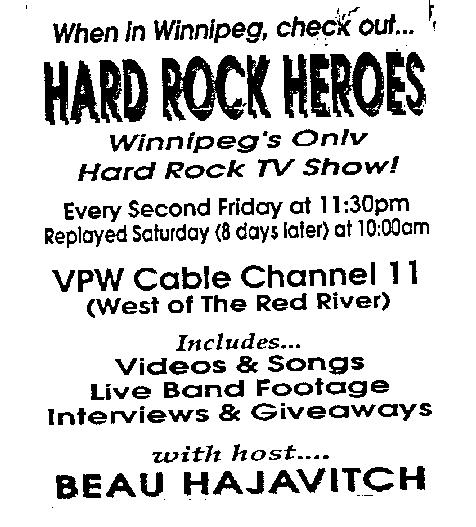
I guess we'll start with the famous Hard Rock Heroes backdrop, since that's the first thing I did for the show.
I knew I wanted a background that resembled some sort of alley, street-type of scene with graffiti on it that looked rock-and-roll-type cool. Basically, combined with the band pictures scattered throughout it, it would look like a combination of an alley and a rocker's bedroom. (And when I say "graffiti," I don't mean today's uncomprehensible hip-hop gang tags. I mean good old fashioned words and letters written with a can of spray paint. That's what graffiti was in the old school days of the '70s and '80s.) I didn't know exactly what I was looking for when I went to buy poster paper at the mall and I can't remember why I chose green. (Maybe because of Poison?) But green it was, and that paper was what I used to spray "Hard," "Rock," and a lousy "Heroes" on. (That "Heroes" was crammed in too tightly - my mistake.) So green and black became the official colors of Hard Rock Heroes, and that's why the background color is green throughout this website. (Later on, the WWF's Degeneration X would appropriate that color scheme, but you know who had it first.) In order not to damage anything, I went to a strip mall close to my apartment after all the stores were closed and placed the green poster paper on the cement walkway. I then spray painted the above words and sat there for a few minutes, watching them kind of dry. Then I carefully picked up all three pieces and carefully walked them back to my apartment upright and so they would not touch each other. When they fully dried, I cut around them with scissors and taped them to the black paper which was actually four pieces of black poster paper taped together. Then I added the band pictures, all of them from Metal Edge Magazine. Then, taking some advice from VPW technicians, I went to Beaver Lumber and bought two pieces of wood and two thick metal coat-hanger-like hooks (my only purchase ever from a lumber store) to screw into the wood. Then, using special glue, I glued the wood to the backdrop. This allowed me to hang the backdrop from the metal rods in the Videon studio, and that's how you saw it hanging there on each show. The backdrop doesn't exist anymore, but I did consider calling the Smithsonian Institution to see if they might want it. (They could put it beside The Fonz' leather jacket.)
The theme song to Hard Rock Heroes (after I jump down and do my screaming in the intro) is "Seventeen" by Winger. This was such a big song in the late '80s/early '90s, it was so big in Metal Edge, and yet the big so-called "rock radio" station in Winnipeg wouldn't play it, and they wouldn't say on air why they wouldn't play it. They were too busy playing oldies from the '60s and '70s to play much current music. I had grown up with the idea that rock magazines mirror rock radio, and vice versa. Now in the late '80s, that didn't seem to be the case anymore, as there were a whole slew of either bands or songs in Metal Edge that weren't getting airplay. I wanted the theme music to Hard Rock Heroes to be a song that was the epitome of this calamity, the most extreme example of a huge song that had no Winnipeg airplay. Other examples included "Up All Night" by Slaughter, which I played as the first song on the first show; I heard that station play that song only once on the graveyard shift. (They sure liked to play "Fly To The Angels," though.) As well, BulletBoys, Trixter, Pretty Boy Floyd, and an American Music Award winner for best new group one year, Firehouse, got absolutely no airplay on this Winnipeg "rock station." It was embarrasing and I regularly advised viewers to get cable radio so that they could hear the top 40 FM station from Fargo, N.D., which did play Firehouse and other heavy rockers mixed in with Belinda Carlisle and Madonna. (A bit off topic, but I loved that Fargo station because I had grown up loving top 40, too, and Winnipeg had no top 40 station by then.) Incidentally, today that "rock radio" station is now a classic rock station, so they could be bringing back the music from all those great hair bands (that era was over 10 years ago now), but do they? No.
People ask me where that footage of street frontage comes from that plays with the crazy stuff on the screen during the songs. I shot it myself! That's me driving around the Winnipeg suburbs of St. Vital and Southdale with one hand on the wheel and the other hand on the camera. I had two tapes; a summer one and a winter one with snow in it. Shooting the winter one was fun - keeping the window partly rolled down the whole time so I could shoot the camera out it and as a result, having to keep the heat in my car on at full blast so I wouldn't freeze. Plus if I was stopped at a red light I had to try and move the camera around so it wouldn't focus on the sign of any particular business and constitute advertising. Which leads to the next anecdote.....
VPW had their very stringent rules about what constitutes plugs or advertising. If I was plugging a concert or a band at a bar on a certain date, I couldn't give out the name of the venue. It wasn't allowed. I had to say stuff like "the big place on Elizabeth Road" (which was Night Moves) or "the big place on McPhillips" (which was The Diamond Club). I usually didn't mind that; I figured my audience knew what and where I was talking about anyway.
 |
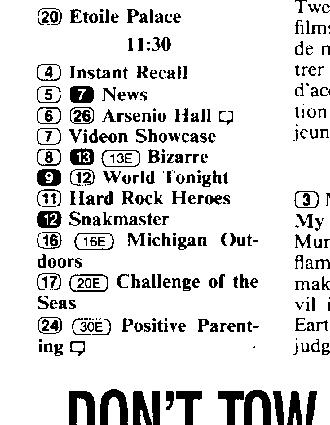 |
| TV Listing in The Winnipeg Free Press. | TV Listing in The Winnipeg Sun. |
All the band footage was shot by me with my camcorder. I couldn't shoot the interviews because I was in them, so those were mostly shot by a girl I met named Tracie or her sister, Diane. It was a pure coincidence that around the time I had already started doing the show, I ran into a girl at Winnipeg bar The Zoo that I had run into a few times and had previously tried to pick up. She was there this time with Tracie. She introduced us, and Tracie told me of how she had the guys from Slaughter over to her place when they were in Winnipeg warming up for Cinderella at the Winnipeg Arena. We traded phone numbers, I found out how big a fan she was of rock stars, and she became my prime camerawoman. I don't know what would have happened to Hard Rock Heroes if I hadn't met Tracie. When I covered Cinderella and Slaughter, I was able to book VPW's mobile. However, that was a concert; 99% of the gigs I would be covering in the future would be at bars where I would be shooting stuff anywhere between 10:00 p.m. and 3:00 a.m. The VPW mobile had to be back in the studio by around 11:00 p.m., I think. Or I may be shooting an interview in the afternoon and the band footage at 1:00 a.m. How do you do that in one booking? So I was lucky the stars aligned, and everything just happened to come together. If I had this part of it really thought out beforehand, maybe I wouldn't have done Hard Rock Heroes!
I knew I wanted to incorporate comedy into the show somehow. I think the home video "Kiss Exposed" was a big factor in this. Plus, even though I was dressed as this big rocker-type, I wanted to show other sides of me, like the comedic side. I guess I was more comfortable doing the quips and gags while hiding behind the metal maniac persona, because that wasn't what I was there for; in other words, it was secondary and the fans may not have expected it from me and I wasn't under any pressure to perform or come up with anything. So the cornball jokes just showed up on the sidelines whenever. I did a whole show ironing; the premise was that I didn't have time that week to do my ironing, so I did it as I was doing the show. I did a Halloween show where I dressed up as David Letterman (the way he dressed on his old NBC show). I did an all-Guns-'n-Roses show where I dressed up as Axl Rose. I wanted to create other unseen characters that could have funny personas that were never seen (like Jenny Picalo on Happy Days before she was finally seen), but I didn't really have the time or resources to think that idea fully through, almost except for Irving the technician, who I tried to paint a picture of as being a slob who regularly screwed up what you saw on your screen and ate sandwiches while he worked. I never even got around to coming up with a proper silly last name for Irving. Later on, I came up with Louie the cameraman, but didn't get around to even thinking up a persona for him, probably because Louie was the cameraman's real name and I didn't want to offend him. (Actually, the way that started was I asked him on air what his name was as part of a skit - I already knew his name - and I expected him to answer me with some dumb made-up name so I could have a new character. Instead he gave me his own name. Maybe he didn't understand what I was going for.)
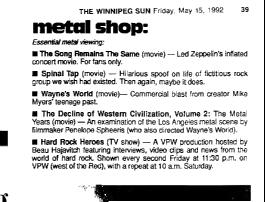
Also, along similiar lines, in keeping with this cartoon persona I had of "Mr. hard rocker," I would only wear three jackets on the show: my black leather jacket, my jean jacket, and a black raincoat/satin-type jacket that was all the rage at the time. That last jacket had more to do with looking desirable to the opposite sex that liked rockers than with hard rock per se, but getting laid has everything to do with rock and roll, right?
Unfortunately, though, as the last paragraph leads into this one, for some reason girls never watched the show. While there was a sizable amount of sexy females that were interested in hard rock and hung out in rock clubs and dressed the part, for the most part they didn't watch television. Certainly they weren't doing whatever the guys were doing to find Hard Rock Heroes on their TV screens every second Friday at 11:30 p.m, whether that meant flipping channels with the remote, reading the newspaper TV listings, or whatever. Guys always recognized me in the bars and would gush all over me like I was their big hero and girls almost never recognized me. So being this big TV star never really got me laid. Oh, well.
I want to say some things about the closing credits. Like everything, I wanted to make them look unique, to stand out in some way. I thought maybe I would put some kind of closing quote at the end of the show, some sort of words of wisdom. (Kind of like today when people put quotes on their "signature" on e-mails or internet newsgroup postings, which I hate. A TV show that you watch more than once over time where you sort of "get to know" the show and the host, I feel, is different.) I knew that Lou O'Neill, who at the time wrote a column for the back page at Circus Magazine, often ended his column with a quote. So I went into my back issues of Circus to see if I could find anything appropriate. I came up with the now-famous end-of-Hard-Rock-Heroes-quote, "Small opportunities are often the beginning of great achievements." It could apply to anybody, although what I was really thinking of when I included it was becoming a VJ at Muchmusic (covered briefly in Part 2 of the "Beau Hajavitch's Biography" section). Then there was the "Beau's wardrobe from the Beau Hajavitch collection" blurb. I had seen a fashion photo shoot Jesse Ventura did in a magazine for clothes where in the credits they identified where all the clothes Jesse wore had come from. For the shades Jesse wore, the captions read, "From the Ventura collection." That's where I got that idea from. And a lot of good having my address at the end of the show was. Almost 3 years of doing Hard Rock Heroes, and I only ever got, I think, two letters. No song requests, no comments, no nothing. I guess no one had any ideas for the show. Kind of makes me wonder if the show was on was now, would I get e-mails if I had included my e-mail address, since e-mail is easier to send? Guess I'll never know. (E-mail from this website is not the same as e-mail from watching a TV show.) In fact, no one in the bars even commented on the "Beau Hajavitch's collection" blurb, like to tell me how funny it was or how cornball it was, etc. Maybe no one reads credits except for those of us who are interested in "the business."
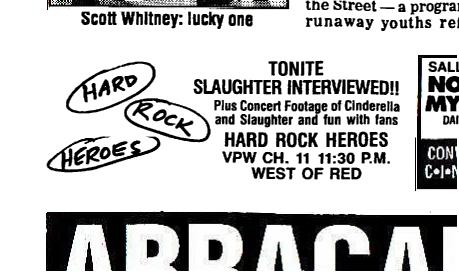


The only entire show I ever did on location was the "Norma Jeans Jam Night Show." Monday nights used to be jam night at a bar in the Exchange district of Winnipeg's downtown called Norma Jeans that had bands. (That bar later became The Riverside Roxy, and today is called Lot One 15.) They were pretty famous as rock radio was behind them, and you never knew who would show up in Winnipeg's elite rock band community. I decided to do a whole show there as it's not like there were tons of people there like on a weekend night that would get in the way of the camera. Now, remember, this wasn't like regular television: I had no headsets, no camera lights, nothing. Just the regular camera, tripod, microphone, and cameraperson. So for the first segment, which was just me talking, yes, a few people walked in front of the camera just passing through. That wasn't so bad, but it felt weird talking into this mic with a normal voice and not hearing myself. I didn't need to raise my voice because I knew the mic would pick up my regular voice fine. But normally when a band is playing and you try to talk to someone in a bar, you either almost have to shout or you have to talk into someone's ear. And I tried to avoid that when I was interviewing people later in the show, but we could barely hear each other! Wendy Cameron of Angel Heart (now with Wild Orchid) did forget one time and tried to talk to me in my ear instead of into the mic and you could see it if you saw that show. but it was a fun show to do. At the time Hard Rock Heroes was cancelled I was about to make the necessary phone calls to do a location show in Gimli, MB at Sunfest, an annual multi-band rock show that used to take place every summer.
Then there was the "Birthday/Anniversary Show." I decided I would throw a party in the studio for an episode of Hard Rock Heroes to celebrate one year of the show in November, 1991. Now, for a TV show, do you call it a birthday or do you call it an anniversary? I don't know, so I decided to call it both! I invited everybody in Winnipeg's hard rock music biz to come, but on a Friday night taping, it's kind of hard to find anyone who doesn't already have plans. So all we had were my main cameraperson, Tracie, and two of her friends. And I had to pick them all up and get to the taping with A Hard Rock Heroes birthday cake in the car plus my backdrop! That was a fun ride. Then about one minute before we start taping, my friend Rocky, who used to work at Mother's Records in Winnipeg, and his little boy Justin show up, so it turned out to be not too bad. We didn't really know what to do while the songs were playing, though, as the cameras were shooting us, but we did have the cake to eat, so we ate that, then just kind of kibitzed around. Sort of like the opening credits of Beverly Hills 90210, but with birthday hats and noisemakers. Then near the end I played some sound bites. This was an idea John Kendle, Entertainment Editor for The Winnipeg Sun gave me: He left a congratulatory message on the one year anniversary of Hard Rock Heroes on my home answering machine and said I could play it on the air, so I turned it into a big joke: I got one or two other Winnipeg music notables to call me and leave me similiar messages to play on the air, then I had my grandmother leave one! And I played them all in a row with hers last. That was funny. So it could have been a disaster of a show, but it turned out all right in the end.
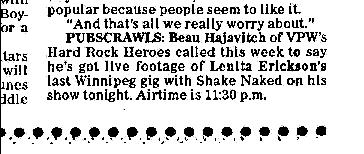
Amazingly, I never really had any problems interviewing bands on the show. Each one of them went smoothly - no one was late or didn't show up or anything. There were a few minor language problems with Jack Damage and maybe Slik Toxik, but we fixed those in the studio. The biggest problem I guess I had was when I was setting up to interview Ballroom Zombies and realized I forgot to bring a tape with me. Luckily, we were doing the interview in lead singer Robin Black's apartment, which at the time was two blocks away from mine in Osborne Village. So I just walked to my place and got a tape while Tracie kept the band entertained. (And no, not in that way.) I have noticed that any band that is signed to a record label is much more eloquent in public speaking than a band that only plays the bar circuit. Doesn't matter how big or small the label is, if they're signed they seem to be much more confident in promoting themselves. I guess they've been briefed or trained by their people how to do interviews. And Lee Aaron was very adorable and charming in person. I got the chance after I interviewed her to tell her that she was born three days after me! Nazareth sure drank a lot. We did the interview, then went back to the lounge in the hotel where I met them. There they proceeded to drink the bar dry for several hours. I had to work at my day job the next day, Monday, so I had to leave, but I left Tracie there and she continued to party with the guys. I couldn't even see their show the following night as I was taping my show on Monday nights during this time.

The first time I "interviewed someone" it was really stupid. I hadn't yet learned everything I needed to know about my camera equipment and microphones, so I did a segment with Tracie on the proposed new location for a new arena in Winnipeg, south of the Winnipeg Convention Centre. I stood by the site during a weekday on Carlton Street, thinking I would interview passers-by on their thoughts on this site for a new arena that would feature great rock shows. I was still using the little mic that was on the camera itself as plugging in a real mic gave me weird noises when I played the tape back. (I later found out I needed a special type of microphone.) But I wanted a mic in my hand to hold in my face and in people's faces to show I was a real interviewer, so I used a "dummy" mic as a prop. That is, I had the mic cord go behind me and into my pants behind my jacket! I interviewed only one woman walking on Carlton Street about the new arena as no one else was going my way that day. I can't remember if the mic cord "disappearing" behind me is visible on air or not, but with the wind outside you can just barely hear what she's saying. Ah, the learning has to start somewhere!
On the last episode of Hard Rock Heroes, I mentioned how the show would be moving to cable radio on broadcasting school NIB's (National Institute Of Broadcasting) new radio station. The Winnipeg Sun printed my quote about that as well. It did not come to be. NIB came about because I had gotten curious about formal training, my lack of it, and what it could do for what I already brought to the table as the host and producer of Hard Rock Heroes. Back then, the only broadcasting school to run at night, because I worked during the day, was NIB. So I enrolled as a night student in 1993. Boy, what a shitbox that place turned out to be. The doors were locked when I went for classes or to do projects. I learned more from the receptionist than I did from the boss or the instructor. The boss only thought about his day people and forgot about us, his night students. And the instructor was an old CBC guy who was so pro-CBC and so anti-commercial radio (his famous quote to me was "commercial radio will eat you alive") that the course should have been called "Broadcasting For The CBC." He once angrily told me that Tom McGouran was not a qualified broadcaster. I didn't officially graduate. I attended every regular class then just never showed up again. I wanted to report them to the appropriate authorities but I didn't have the time because those last few classes were during a two-month period in my life where I had to work an unscheduled overnight shift for 8 weeks at my job so that was my first taste at doing not much else in a 24-hour period besides working and sleeping. I was lucky to even make those last few classes. If that boss and that instructor are reading this: please go to hell. If Lisa, the receptionist, is reading this: Thank you for your kind help. This paragraph is being written in 2008, and at this time, while I would love to do a radio version of Hard Rock Heroes on today's citywide campus radio stations KICK FM, CKUW, or CJUM (UMFM), I am older now, and with the working I do and the sleep I need, I just don't have the time. Maybe someday.
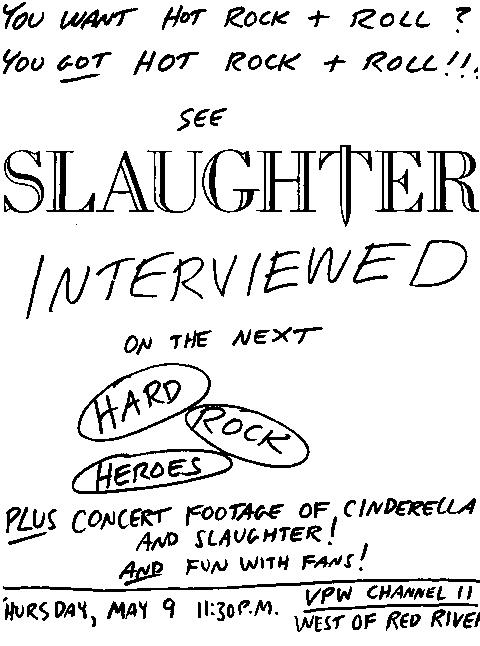
Well, that's about all I can think of for show anecdotes. I'm sure you had just as much fun reading them as I had writing them, or hell, living them. Some of the things I describe above you can see visually in photos either in the Photos section, or elsewhere on this site. Check 'em out! And thanks for your time, dudes and babes!